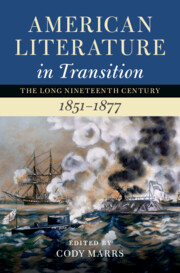Book contents
- American Literature in Transition, 1851–1877
- Nineteenth-Century American Literature in Transition
- American Literature in Transition, 1851–1877
- Copyright page
- Contents
- Figures
- Contributors
- Series Preface
- Introduction
- Part I Careers
- Chapter 1 Emily Dickinson
- Chapter 2 Frederick Douglass
- Chapter 3 Augusta Jane Evans
- Chapter 4 Herman Melville
- Chapter 5 John Rollin Ridge
- Chapter 6 Walt Whitman
- Chapter 7 Anonymous
- Part II Networks
- Part III Exchanges
- Part IV The Long Civil War
- Index
Chapter 1 - Emily Dickinson
from Part I - Careers
Published online by Cambridge University Press: 15 June 2022
- American Literature in Transition, 1851–1877
- Nineteenth-Century American Literature in Transition
- American Literature in Transition, 1851–1877
- Copyright page
- Contents
- Figures
- Contributors
- Series Preface
- Introduction
- Part I Careers
- Chapter 1 Emily Dickinson
- Chapter 2 Frederick Douglass
- Chapter 3 Augusta Jane Evans
- Chapter 4 Herman Melville
- Chapter 5 John Rollin Ridge
- Chapter 6 Walt Whitman
- Chapter 7 Anonymous
- Part II Networks
- Part III Exchanges
- Part IV The Long Civil War
- Index
Summary
While Emily Dickinson (1830–1886) is often described as a private poet and there is no firm evidence that she shared either her fascicle booklets or the great majority of her poems with anyone, there is good evidence that Dickinson drew public attention to herself as a poet from her early years. In this sense, Dickinson was not at all private about her poetry. As a young woman she shared her poems and thoughts about poetry with readers whose response mattered to her, and doing so may have given her the confidence she needed to become the “Emily Dickinson” we know. She also wrote occasional passages of metered prose in her letters of this period – from a few beats to multiple implied lines and rhyme. In the final years of her life, her use of metered prose became more prominent. This essay will focus primarily on the decade during which Dickinson shaped herself as a poet, roughly from the late 1840s to 1858. After a brief review of the years of her greatest productivity, I will pick up my story of Dickinson’s transitions with the 1880s, when she increasingly wrote at this border of poetry and prose. While some aspects of Dickinson’s themes and style changed over her lifetime, as early as 1853 she had settled into the rhythms of highly compressed, short-lined metrical verse she would maintain – with rare exceptions – for the rest of her life, including in her passages of metered prose.
Keywords
- Type
- Chapter
- Information
- American Literature in Transition, 1851–1877 , pp. 13 - 26Publisher: Cambridge University PressPrint publication year: 2022

